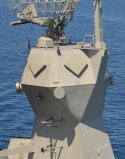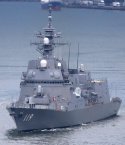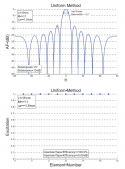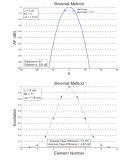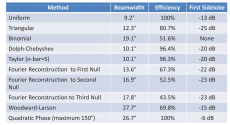Hmm. I can't really tell what the smaller array is. Do you have a better photo?
The new tracker/illuminator on the 054(B?) is not comparable to these systems. CEAMOUNT is only a transmitting antenna. It is slaved to the CEAFAR search and track radar. Similar for the FCS-3A on the Akizuki class.
If the new antennae are X-band only, and they can multifunction between track and illuminate, then they are most similar to APAR-X or SPY-3. Although, the latter perform the search role as well, but these panels are not at their optimal height for that role. Are you positive that these panels are not part of an EW suite? Instead of an ICWI capable seeker, the new HQ-16 variant might have an ARH seeker?
1.)
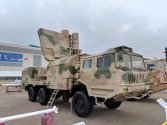
2.) CEAMOUNT is probably slave/transmitter only but FCS-3A is likely a true FCR. The FCS-3A is the only thing in the Akizuki class that can also serve as a gun fire control radar so I don't think its a slave only. If CEAMOUNT can track targets separately and does not need to be slaved, CEAFAR is free to search, detect and track new hostiles, which I think is a better idea.
2a). If these new arrays can track targets separately, they don't need a primary search function. Other radars can search and cue to the FCRs to the targets, and once that is so, leaving the FCR to track the targets separately in a high quality mode. This is duplicating what the MR-90s already do.
3.) I don't know if its EW. This type only first appeared in the last four 054A in 2016 making it fairly new, and reappeared in the 054A/P and 054 refit. The housing of the 726-3 contains a set of phase arrays. Here is the set as it appears on the refitted 525 Maanshan. No. 31 has not been fitted with its EW equipment as during the time of launching, but its likely something scheduled to be done in the fitting phase, and I don't see any reason why they won't add this, unless they are launching a new ECM fit once again.
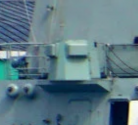
Older Type 751 ECM with most Type 054A for comparison.
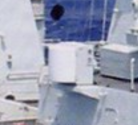
4.) The other possibility is that it might be CEC as these are sized similar to the CEC antennas. However, CEC antennas are better served if they are located higher like on the mast and can only be low for the lack of better alternatives.
Test fit on #515. This ship was in a Gulf of Adens in an escort mission and stopped over at Greece where this picture is taken.
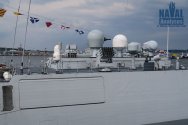
5.) Datalinks for ARH HQ-16. When I think of this, I still wonder if there is any radar that can provide a high or weapons quality track because even ARH missiles will still benefit from this. We know ARH missiles still need to be updated until they are close enough to the target to use their seeker. The question is whether you have a radar that can glare or stare at the targets, and update fast enough for weapons quality tracks. If not one radar can suffice (Type 382) then two (Type 382 + Type 364, or even Type 366 added) using track combine. Or use the gunnery FCR (Type 347/349). However if longer ranges, you have to depend on the Type 382, until the target is within range of the Type 364) and line of sight of the Type 366 in order to use track combine. Possible if the ARH HQ-16 has a range up to 60 to 70km, which is still within range of the Type 364. But if you need datalinks then the range goes beyond the Type 364, and you have to rely completely on the track quality of the Type 382, which might have to be aided with track prediction. IMO, if the Type 382 is able to give weapons quality tracks for ARH missiles, then you won't need Type 346 on the 052X series, and you might as well use the HQ-9 or a smaller version of it, on the 054A. This radar only electronically scans in the vertical and the horizontal measurement is dependent on the rate of mechanical rotation. Its accurate enough to queue other radars, like say the MR-90s, towards their targets, which then the MR-90s take over for an even more accurate scan and track. Is the Type 382 + Type 364 track combine accurate enough to use the MR-90s in a completely transmit only slave mode?
If I look at other foreign examples, the Redut, for example, while active, still requires the Poliment FCR to bring the missiles to the target catch basket. The Poliment is a set of fixed X-band phase arrays, and the Redut doesn't rely on the rotating Furke search radar. Rotating phase arrays that serve the ARH Aster, such as SAMPSON, EMPAR, Herkales and Kronos, might have glare modes where the face would glare at the target instead of continuously rotating at a constant speed. During these glares, the face achieves a 3D scan, both horizontal and vertical without relying on a mechanical rotation for the horizontal reading. With all electronic 3D scans, the face can achieve any number of fast scans to reach enough updates for a weapons quality track.
IMO, I maybe a bit more confident that the HQ-16 might have gone ARH if the main search radar for the Type 054A has been changed. The new fixed arrays can be datalinks only for ARH, or they can be illuminators + datalinks for SARH.
6.) Why I think the new arrays are MR-90 replacements, used for track and illuminate. They are located near where the MR-90s are formerly located. While location is not an absolute reason why it is, for me, that's a vital clue. Do they operate in a transmit only slave mode? One has to assume Type 382 + 364 combine track is accurate enough with algorithms predicting and refining on the track. I think both Type 382 and 364 only work to cue the FCRs towards the targets, leaving the FCRs to track in high quality and engage while the search radars leave off to detect the next wave of incoming threats. That's likely how they worked before.
